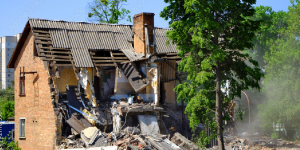Partial Demolition and How it Boosts Real Estate Value
Introduction

In the realm of property development, there’s a technique that’s gaining momentum in Australia – partial demolition. Contrary to the image that ‘demolition’ conjures, this process isn’t about tearing everything down. Instead, it’s about strategic removal, allowing the best parts of a structure to shine while providing a platform for modern enhancements. In this post, we’ll dive deep into partial demolition and uncover how it’s proving to be a game-changer in boosting real estate value in Australia.
Environmental Considerations in Australian Partial Demolition
Caring for the planet is more crucial than ever, and the world of demolition is no exception.
Sustainable Waste Management Practices
In the world of demolitions, sustainability has increasingly taken center stage. As environmental concerns gain prominence, partial demolitions have come to be recognized as a more eco-friendly approach compared to their full-scale counterparts. This practice includes Reduced waste production and less strain on landfills.
Carbon Footprint Reduction and Green Demolition
Partial demolition doesn’t just stop at producing less waste; its environmental benefits extend to reducing the carbon footprint as well. Given that there’s less waste, there’s a corresponding decrease in the transportation required to haul this waste to disposal sites. Partial demolitions, being more targeted, typically utilize fewer machines for shorter durations. This means less energy consumption and fewer emissions during the demolition process.
Cost Analysis: Partial vs. Full Demolition
At its core, whether total or partial, demolition involves significant costs. But there’s a stark difference when you put these two side by side:
- Material Costs: In a partial demolition, fewer materials are wasted since only portions of a building are taken down. This translates to reduced costs as there’s no need to buy new materials for the entire structure.
- Labor Expenses: Full demolition requires extended hours of labor. On the contrary, partial demolition often involves fewer workers and reduced work hours, leading to savings on wages and other associated expenses.
- Disposal Fees: Full demolition produces a more substantial amount of waste, leading to higher disposal fees. With partial demolition, the waste is significantly reduced, which decreases disposal costs.
- Reduction in Relocation Expenses: Often, a partial demolition means that parts of the property remain functional. This can reduce or even eliminate the need for temporary relocations, which can be pricey.
Boosting Real Estate Value with Strategic Demolitions
The strategic approach to demolition can enhance the real estate value of a property.
Preservation and its Economic Value
Properties that bear historical significance are not just about the past but also the value. Their unique architectural features and story can attract a niche market willing to pay a premium. The charm of antique woodwork or period-specific architecture can become a significant selling point.
Modernization – Blending the Old with the New
Modern amenities combined with a touch of history create properties that stand out in the listings. Think of a Victorian-era mansion with a modern, state-of-the-art kitchen or a revamped open floor plan. This blend can command higher prices because of its unique appeal.
Demand Dynamics
The demand for properties that offer the best of both worlds – history and modern comfort – has recently seen a surge. Millennials and Gen-Z, who value uniqueness and character, are particularly drawn to such properties. These age groups are entering the real estate market with buying power, driving demand for these hybrid properties.
Long-Term Economic Benefits
Tourism Boost
Heritage buildings that undergo partial demolition and restoration can also attract tourists. Regions with a mix of historical and modern architecture become attractive tourist spots, bringing in local revenue.
Local Employment
Restoration projects often employ local artisans, craftsmen, and workers, fostering community growth and creating job opportunities.
Sustainability and Economic Savings
Reusing existing materials is sustainable and can lead to long-term economic savings. By preserving the old and minimizing the use of new resources, we are taking a step toward a sustainable future, which is economically beneficial in the long run.
Challenges Specific to Australian Partial Demolition
While beneficial in many aspects, partial demolition poses its unique challenges, especially in the Australian context. Here’s a closer look at the hurdles that property developers and contractors face in this region.
Dealing with Asbestos in Older Structures
One of the paramount concerns when undertaking a partial demolition of older buildings in Australia is the potential presence of asbestos. Asbestos was used predominantly in building materials before the 1980s and poses serious health risks.
- Health Implications: If disturbed, asbestos releases fibers that, when inhaled, can lead to diseases like asbestosis, lung cancer, and mesothelioma. The protection of workers and nearby residents becomes paramount during a demolition.
- Specialized Training: Workers need specialized training to identify and safely remove asbestos-containing materials.
- Cost Implication: Proper asbestos removal can be expensive. It involves specialized equipment, suits, and often, third-party testing and certification to ensure complete removal.
- Disposal Challenges: Asbestos waste needs to be disposed of in specific landfills designed to handle hazardous materials. These landfills are fewer in number and may not be conveniently located, adding to the transportation costs.
Addressing Natural Threats: Bushfires and Coastal Erosions
Australia’s vast landscapes also present unique environmental challenges, especially when you’re preserving portions of a building.
- Bushfires: Regions prone to bushfires require extra caution. Partially demolished structures, especially those with exposed wooden elements, are vulnerable to catching fire.
- Adaptive Techniques: To counter this, fire-resistant materials or treatments that reduce the wood’s flammability are imperative. Site planning to create buffer zones or firebreaks around the property can also minimize risks.
- Coastal Erosions: For properties near the coastline, the continuous beating by waves, especially during extreme weather conditions, can weaken the foundation.
- Environmental Considerations: Coastal properties often have unique ecosystems. Disturbing these areas during partial demolitions can have ecological impacts, from affecting marine life to altering sandbank structures.
The Imperative of Hiring a Professional Demolition Team

Tackling a partial demolition is a straightforward task. However, the intricacies involved, especially in the Australian context, necessitate the expertise of a professional demolition team.
Safety First
Demolishing even a part of a building is risky. A professional team is trained to handle these risks, ensuring the safety of the workers and the surrounding community.
Knowledge of Regulations
With many regulations concerning older and heritage properties, a professional team is adept at navigating the legal landscape, ensuring that all activities are on board.
Efficient Use of Time and Resources
With their experience, these teams can execute the job efficiently, saving time and reducing the possibility of costly mistakes or do-overs.
Specialized Equipment
Professional demolition teams come equipped with the right tools for the job. Whether safely removing asbestos or ensuring that a structure is sound after a partial demolition, their specialized equipment makes a difference.
Environmental Responsibility
They also understand the importance of environmentally friendly disposal practices, ensuring waste is managed and discarded responsibly.
Peace of Mind
The most crucial aspect is the peace of mind that property owners receive, knowing that their project is in the hands of seasoned professionals who will prioritize both efficiency and safety.
While it might be tempting to cut corners or attempt a DIY approach, partial demolition’s complexities, and potential pitfalls make hiring a professional team not just advisable but essential. They transform a daunting task into a seamless process, ensuring the best outcomes while minimizing risks.
Conclusion
Partial demolition, especially in Australia, is a balance of preserving heritage and embracing modernity. It offers an avenue to boost real estate value, preserve historical significance, and cater to contemporary needs. However, with its benefits come challenges that demand expertise, caution, and meticulous planning.
Introducing Rapid Demolition: For those navigating the labyrinth of partial demolition, our company, Rapid Demolition, stands as a beacon of assurance. With years of experience in the Australian demolition industry, we pride ourselves on our comprehensive understanding of local regulations, our state-of-the-art equipment, and our team of dedicated professionals. We prioritize safety, efficiency, and environmental responsibility in every project. At Rapid Demolition, we offer services and peace of mind, ensuring that your vision for your property is realized with precision and care. Consider us your trusted partner in this journey for any partial demolition needs.
